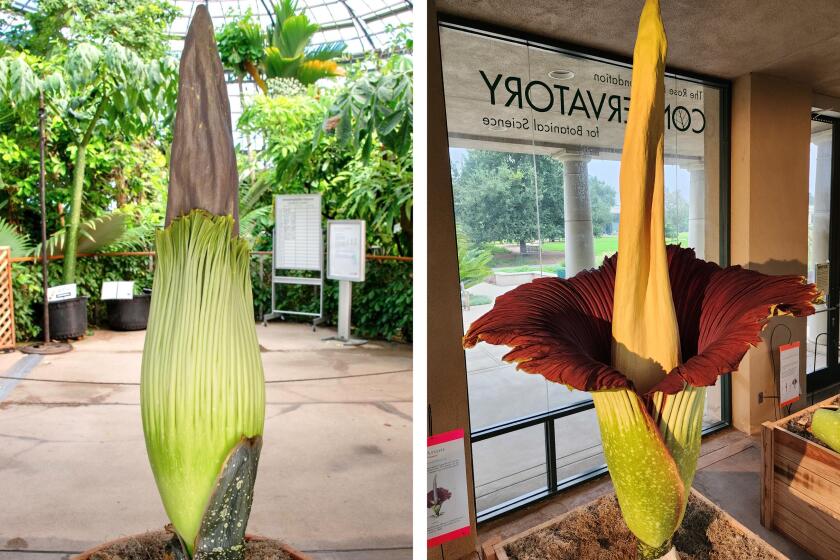The Invincible Oleander Meets Unmaker in Bug
When it came time to decide how to landscape the Tustin Market Place shopping center, there was hardly any hesitation. There would have to be oleander shrubs, those lush, evergreen, flower-laden staples of Southern California greenery that line the freeways and withstand the hottest summers and driest droughts.
Soon there was a profusion of flowering oleanders decorating the shopping center.
Now they’re dead and gone, and nearby, roadside oleanders are being ripped out and replaced as well.
The miles-long privacy hedge of oleanders that surrounded the Annenberg estate in Rancho Mirage is gone too--replaced by a stark concrete wall. And some of the oleanders at the golf course across the road are dead, looking as if they’d been blasted with a blow torch.
The oleander--a shrub so hardy, trouble-free and drought resistant that it became a mainstay of the Southern California roadside landscape--is being assaulted by germs carried by an insect new to Southern California--the glassy-wing sharpshooter leafhopper. Together, bug and bacterium are threatening to make the oleander a mere memory.
The blight has descended on Orange, San Diego and Riverside counties. It is also reported to have touched down in Los Angeles County as well, though horticulturists haven’t yet confirmed any cases.
Both the bug and the bacterium are cousins of the team that caused Anaheim disease, the blight that in the late 1880s wiped out the flourishing wine industry in Orange and Los Angeles counties. That blight, now known as Pierce’s disease, is so persistent that grapevines planted today in the Santa Ana Valley, Westwood or Brentwood would have little chance of survival.
Caltrans, which regularly receives fan mail from tourists praising the oleanders along its freeways, is very worried. It has perhaps 100,000 of the shrubs statewide, 15,000 in Orange County alone.
In an attempt to save its oleander forest, Caltrans has hired UC Riverside to find a pesticide that might help. At stake is whether lush greenery on freeway medians will have to be replaced with concrete and steel.
But some researchers believe there is little chance of successfully fighting the pest. The University of California formed a task force in spring of last year, but a year of study has not prompted any optimism.
“We don’t have any way to combat this disease,” said Alex Purcell, a professor in UC Berkeley’s division of insect biology.
There is no cure for the bacterial infection, and trying to kill the insects carrying it “just isn’t going to work,” Purcell said. “You can control 99% of the insects and reduce the spread by only 5%,” because remaining bugs would be more than enough to keep the disease spreading. It takes just one bite to infect a plant, he said.
The nursery business is worried too. In Orange County, raising nursery stock is the largest agricultural industry by far--with a $133-million-a-year wholesale value.
The California Assn. of Nurserymen has given $10,000 to UC Riverside to determine whether this new disease is a threat to other plants. So far, only one has been found: periwinkle or vinca major, a popular ground cover with dark-green leaves and lavender blue flowers.
*
The disease, called oleander leaf scorch, has no cure, researchers say. It was first noticed in Palm Springs in the late 1980s but didn’t come to the attention of scientific investigators until 1993.
A year later it was identified 75 miles away at the Tustin Market Place, a shopping complex in the Tustin Ranch area along the Santa Ana Freeway.
Apparently it was carried there in nursery stock. The bacteria multiply so slowly that symptoms do not appear until a year after infection, said Purcell. “This was before anyone knew the disease existed. You can’t really blame anybody.”
The center, built in stages beginning in 1988, “had a ton of oleanders,” said Michael Wilson, the center’s operation manager.
But their leaves, usually a rich green no matter the season, were turning brown along the edges. They looked as if they were getting no water, and Wilson called his landscaper to complain.
“We were completely in the dark,” recalled David W. DuBois, president of Mission Landscape Service in Santa Ana. “We’d been maintaining them for four or five years. There was water at the roots, but it wasn’t getting to the plants. They were dying, and normally, you can’t kill these plants if you try.”
Ralph Carhart, senior landscaper for Caltrans, was puzzled as well. Since the 1930s, oleanders have been planted along the state’s roadsides and median strips in the harshest climates, “because you could always count on them,” he said. “They could be burned up or wiped out by a traffic accident and they’d come right back up from the ground.”
He estimates Caltrans could have 100,000 oleander shrubs growing between the Mexican border and Redding. “About the only place they don’t grow is the Sierras and the north coast,” he said.
The potential for such widespread infection is “a nightmare,” Carhart said. As if to bring the point home, the oleanders at Caltrans’ maintenance yard in Orange are dying.
“For all practicality, I can tell you we would not attempt to replace the oleanders in the medians. If there’s a replacement, it will be something engineered,” meaning concrete or steel.
Kevin Tong, Caltrans landscape architect in Orange County, says maintenance crews have tried severely pruning infected oleanders, but while the foliage grows back seemingly healthy, it’s still infected and doomed.
“It might squeeze another year or two out of the plant, that’s all,” he said.
To add insult to Caltrans’ misery, recent tests by Marcy Grebus, a plant pathologist at UC Riverside, indicate the disease can be spread by unsterile pruning tools, a first for this family of bacteria. (A 10% to 20% solution of household bleach should kill the bacteria, Grebus said.)
The disease has been spreading outward from Tustin Market Place and has became a problem for Martin Pastucha, Tustin’s park and street maintenance manager. About 8,500 oleanders decorate Tustin streets.
“We’re replacing 1,600 now at major intersections,” said Pastucha. “We have to do it in stages; replacing them all at once would cost maybe $200,000.”
No other city in Orange County has such a severe problem, but that may be only a matter of time. Researches say they have reports of infected oleanders in Newport Beach, Irvine, Lake Forest, Orange, Anaheim and Brea, as well as Palm Springs and other parts of the Coachella Valley, and the Scripps Ranch area of San Diego County.
“It was a very welcomed plant to California, but now it’s not being specified anymore on new jobs,” said DuBois. “I still see some places planting it, but I don’t know why.”
*
UC researchers say they can’t tell how long this bacterium has been in California. It can exist in some plants without causing them any harm, waiting to be carried to an oleander by some accommodating insect.
They believe that the glassy-wing arrived sometime in the late 1980s, probably brought into California as eggs in plants. Such infections are supposed to be caught at border checkpoints, but because the eggs are inside plant tissue, they’re easy to miss, Purcell said.
There had been sharpshooters in California before; one of them was responsible for the spread of Anaheim disease. But the glassy-wing, a native of the southeastern United States, was new to the state.
The characteristic of bug and bush disastrously combined.
One of the oleanders’ virtues was its easy propagation. Merely cut off a branch, plant it in soil and you have a new oleander. But that created new plants that were genetically identical, generation after generation. If a disease could affect one, it could affect them all, and, in Purcell’s words, “we were planting one every 20 feet all the way to the horizon.”
The newly arrived glassy-wing--though it loved to cluster on eucalyptus, apple, peach, citrus and avocado trees, apparently without harming them--turned out to be one of only three insects that also can stand eating any part of the oleander, a plant so toxic that parents are warned to keep their children from sucking the leaves and flowers. Even the smoke from burning oleander can cause illness.
The glassy-wing taps the oleander’s one benign part, its water transport arteries. There is so little nutrition here that the insect must suck in hundreds of times its own weight each day, the highest feeding rate of any land animal, Purcell said.
Consequently it excretes a huge amount of liquid. In citrus and avocado groves where the bug likes to feed and reproduce, “you can walk through on a hot day and it’s dripping like it was raining,” said Purcell.
If the glassy-wing picks up the bacteria from some host plant, it will inject it into whatever oleander it feeds upon. The bacteria, Xylella fastidiosa, remains in the plant’s water system, growing slowly but eventually choking off the water flow to stems and leaves. At that point, no amount of watering at the roots will revive the plant.
Purcell said it’s too soon to predict the long-range effect of the disease. “Sometimes they peter out, and sometimes they don’t,” he said.
The American chestnut was a dominant tree species in the eastern U.S., but disease drove it to near extinction. “Two growing stumps are all that’s left,” Purcell said.
But Dutch elm disease failed to eliminate the elm, “and I think this oleander leaf scorch is going to be closer to that. It’s going to be very serious and going to eliminate oleanders from certain areas, but where and how far the disease will spread, we can’t tell.
“At the very least, there will be places in Southern California where you don’t want to replant oleanders. Nobody’s planting them in Palm Springs, and I wouldn’t plant one in Tustin for sure.”
“At the worst,” Purcell said, “the oleander is going to be a rare plant in California.”
(BEGIN TEXT OF INFOBOX / INFOGRAPHIC)
Oleander Successors
Several plants are under study as likely replacements for oleander shrubs suffering from leaf scorch. Research is in the early stages, so these plants’ immunity to the disease has not yet been scientifically proved, says Marcy Grebus, the plant pathologist heading the project. All fall short of the oleander’s virtues in various ways, she says. Here are descriptions:
* Photina fraseri: Evergreen shrub with glossy, dark-green leaves, bronze-red stems, white flowers. Heat-resistant. Grows to 10 feet. Needs slightly more water than oleander.
* Viburnum: Large, diverse group of deciduous or evergreen shrubs. Clustered, fragrant flowers, sometimes blooming in winter. Tolerates alkaline or acid soils. Some varieties drought-resistant.
* Myoporum: Evergreen shrubs, small trees with bell-shaped flowers, dark-green leaves. Tough, fast-growing, fire-resistant, tolerant of poor soil and direct sun but not extreme heat.
* Rhus lancea (African sumac): Evergreen tree, slow grower to 25 feet. Dark-green leaves, pea-size yellow and red fruit. Tolerates high summer heat. Drought-resistant once established.
* Prunus caroliniana (Carolina laurel cherry): Evergreen shrub or tree with dense, glossy green foliage, small, creamy-white flowers. Withstands desert winds and temperatures. Needs more water than oleander. Slow grower.
* Plumeria: Gaunt, slow-growing, evergreen or deciduous shrubs, trees with large, showy, very fragrant blooms. Won’t survive more than 10 miles inland without cover. Grows to 10 feet.
* Thevetia peruviana (yellow oleander): Fast-growing evergreen shrub, tree related to oleander. Deep-green, glossy leaves, fragrant, yellow-to-apricot flowers, usually from summer to fall. Short but can grow to 8 feet.
* Trachelospermum jasminoides (star jasmine): Evergreen vine or knee-high shrub with light- and dark-green leaves, white, sweet-scented, 1-inch flowers. Moderately fast-growing once established. Good ground cover. Needs more water than oleander. Somewhat drought-resistant.
* Carissa grandiflora (natal plum): Fast-growing, rounded shrub with leathery, dark-green leaves, spines, fragrant, white flowers, red, plum-shaped, edible fruit. Can freeze, even in a Southern California frost.
* Mandevilla: Evergreen and deciduous tropical vine with deep-green leaves and showy pink or white flowers. Frost damage when planted more than 10 miles inland.
* Vinca minor (dwarf periwinkle): Vinca major is susceptible to oleander leaf scorch, but vinca minor, a miniature version, may not be. Evergreen creeper with small, dark-green leaves and 1-inch lavender blue or white flowers. Highly invasive.
Sources: UC Riverside, Sunset Western Garden Book; Researched by STEVE EMMONS / Los Angeles Times



